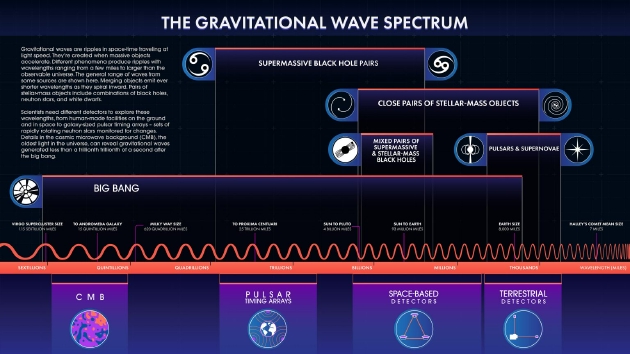Beijing time on May 7th, according to foreign media reports, our cosmic space-time is a “ripple ocean” full of gravitational waves. Astronomers believe that,Gravitational waves around a pair of supermassive black holes in ancient galaxies can reach light-year wavelengths, for the past few decades, scientists have been trying to explore and observe this mysterious gravitational wave.Currently, based on NASA’s Fermi Space Telescope, theyOne step closer to observing “black hole gravitational waves”!
Gamma rays detected by the Fermi Space Telescope are a form of high-energy light. An international team of scientists studied Fermi telescope data collected from pulsars, which are spinning stellar cores that explode in supernovae. They looked for these Small changes in the time it takes for pulsars to release gamma rays to reach Earth,This change may have been caused by gravitational waves on the way to Earth.but they found nothing.
Although they did not detect gravitational waves, the analysis showed that,With more observations, the Fermi telescope may detect the presence of gravitational waves. Matthew Kerr, a physicist at the U.S. Naval Research Laboratory, said: “We were very surprised when we discovered that the Fermi telescope could detect long gravitational waves, and radio research has been doing similar surveys for many years. But the Fermi telescope has some special capabilities that make it a very powerful tool for this astronomical observation.”

When massive celestial bodies accelerate, gravitational waves at the speed of light will be generated. In 2015, the ground-based laser interferometer gravitational wave observatory detected the existence of gravitational waves for the first time. The observatory can detect gravitational wave ripples with wavelengths of hundreds of kilometers. These gravitational waves Wave ripples can zip across Earth in an instant, and the soon-to-be-launched Laser Antenna in Space (LISA) is expected to pick up gravitational waves with wavelengths billions of kilometers.
Currently, Cole and researchers are searching the universe for gravitational waves with wavelengths of several light-years or trillions of kilometers, which means that it takes several years for these gravitational waves to reach Earth. The gravitational wave ripples first detected in 2015 are only gravitational waves. Part of the background, the gravitational-wave background is a randomly generated “sea of waves” created in part by a pair of supermassive black holes, typically located in the central regions of merging galaxies.
To discover gravitational waves,Scientists need a galaxy-sized detector called a ‘pulsar timing array’the array uses a specific set of millisecond pulsars that spin as fast as a blender blade, which will emit beams of radio, gamma rays and other radiation that pulsate with incredible regularity like a cosmic clock .

When the long gravitational wave passes between the pulse wave and the Earth,The radio and gamma rays it releases will arrive later or earlier by a billionth of a secondby looking for specific patterns of pulsing changes in a group of pulsars, scientists hope they will reveal the changes gravitational waves produce around them.
For decades, radio astronomers have observed gravitational waves using the “pulsar timing array” method, which is very sensitive to gravitational waves, but interstellar effects complicate the analysis of radio data. Space is full of messy radio information that spans light-years and produces more complex effects that bend radio trajectories, which change the arrival times of pulses of different frequencies. Gamma rays are not affected by these complex effects.
When detecting the background of gravitational waves, the survey results of the Fermi Space Telescope are 30% more accurate than the pulsar timing array. It is estimated that it will take another 5 years to collect and analyze the pulsar data, which can eliminate the interference factors of free electronic information in space. .
Over the next decade, radio and gamma-ray astronomers hope to pick up highly sensitive gravitational-wave signals orbiting a pair of giant black holes. The Fermi Space Telescope has the unprecedented ability to precisely measure the arrival time of gamma rays, and it has a wide survey field of view. Since the launch of the telescope, it has continuously provided us with the latest information on gamma rays. We are looking forward to Next amazing discovery!
.
[related_posts_by_tax taxonomies=”post_tag”]
The post Fermi Space Telescope searches for mysterious gravitational waves originating from giant black holes appeared first on Gamingsym.
